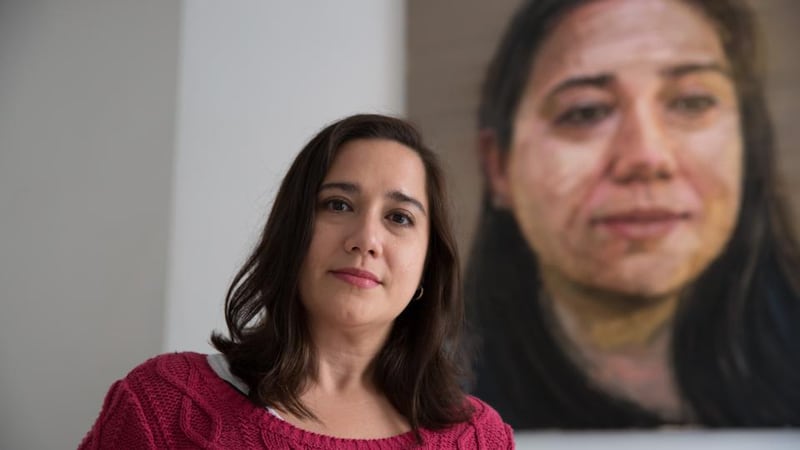Jerusalem is a bold title for an exhibition of portraits. Twelve portraits, to be exact. They are all made in the larger-than-life, photorealist manner that has become a hallmark of Colin Davidson's style. The subjects are male and female. You could break them down further, as Muslim, Christian or Jewish, or Israeli or Palestinian. One thing they have in common is that they all live in Jerusalem. Another, as the Belfast-born artist puts it himself, is that they are all human beings, trying to make sense of the world they live in.
Davidson's show, which is at the Oliver Sears Gallery in Dublin, stemmed from conversations he had with Sears, who says, "Having shown Colin's work previously, I knew I wanted to do another exhibition. He didn't just want to do another series of heads in a general way. So we were looking for a thematic approach, and it gradually emerged."
Sears’s mother is a Holocaust survivor. Davidson grew up in Belfast – “where you’re labelled at birth, and dogged by that identity”, as he puts it, something that goes back to the source of the conflict in Northern Ireland and endures even now just beneath the surface of the peace process. “Even though our backgrounds are quite different,” Sears says, “there was this common sense of intergenerational discrimination and conflict.”

He sees the portraits as an articulation of a necessary plurality. They settled on Jerusalem because it is a highly charged place and because, as Sears says, “I knew I could find subjects there. I know that as a gallerist I work in a privileged, quite detached world. I’ve never been so intimately involved with an exhibition before.”
Several of the portraits’ subjects were in Dublin for the opening of the exhibition. One is Veronica de la Guardia, who was born and grew up in Costa Rice, and studied medicine there.
Now living in Jerusalem, she is a specialist in anaesthesiology and critical care at Hadassah Medical Center. Like many of the subjects, she is multilingual – she speaks English, Spanish and Hebrew – reflecting the breadth of her heritage and the cosmopolitan reach of the Israeli population.
What quickly emerges, once you go into the backgrounds of the sitters, is that any group of individuals in a specific location embodies a tangled mass of interwoven histories. Those histories are compelling and sobering. In Jerusalem some of the personal histories are extreme.
First-name terms
Each sitter, including Veronica, is identified by only a first name, but several are quite well known. Uri, for example, a handsome grey-haired man, is Uri Orlev, the distinguished Israeli writer. He was amused by the exhibition project. “I never saw myself so big,” he says with a wry smile, glancing towards his portrait. Orlev was born in Warsaw, experienced the Warsaw Ghetto during the war years and, when the Nazis shot his mother, was dispatched with his brother to Bergen-Belsen. Immediately after the war they were sent to Palestine.
The kibbutz they entered was a stunning contrast with the life they had experienced, and he loved it, at least during the initial years. "It was like a new message for the world." He says the model became compromised later on – "privatisation" – but he too moved on. He always wrote – and since 1956 he has published more than 30 books, including The Island on Bird Street. Some are autobiographical; most are not. They have been translated into 38 languages. Orlev has a particular gift for writing for young adults; he received the Hans Christian Andersen Award in 1996.
His wife, Ya’ara, cautions: “Uri does not like to be represented as a Holocaust survivor. I think about seven of his books deal with the Holocaust. His feeling is that his experiences during the Holocaust are part of his childhood. His perspective is that of a child. He doesn’t have a message in any conventional sense.”
Inevitably, Orlev encountered people with similar or more traumatic experiences than his own. His book Run, Boy, Run, for example, is based on the true story of a boy who spent two years living in woods outside Polish villages during the war. When he hurt his arm in an accident he was brought to hospital. The doctor on duty refused to treat him, as he was Jewish. Fortunately the next shift brought a different doctor, who told him, "Yesterday I could have saved your arm. Today I think I can save your life."
Orlev lost his arm but lived. He has bemoaned the lack of progress towards peace in the Middle East, but he and Ya’ara like living in Jerusalem for its extraordinary vitality. “We are very aware of the problematic nature of the city, but we love it.”
Two other subjects, Amiram and Yousef, are Amiram Goldblum, a research chemist with an international reputation, and Yousef Najajreh, dean of scientific research at Al-Quds University in Jerusalem. Najajreh is Palestinian. He and Goldblum are friends. "Yousef was one of my scientific collaborators," Goldblum says.
Goldblum is also well known as a peace activist and was for a long time the spokesman for the Peace Now movement. “You could say that I divide my time between human rights and science.” Last year he and a number of others held a public meeting and established Equality: the Organisation Against Racism and Apartheid in Israel.
As a professor at the Hebrew University of Jerusalem and a leader in molecular modelling, a field crucial to the development of drug therapies, Goldblum is a significant figure in Israeli society. But despite “a lot of dear friendships, and very strong connections”, he is for the first time looking at the possibility of leaving Israel, as he is so pessimistic about its political direction.
It’s a sobering reminder of how difficult it is to reach the level of shared humanity that Sears and Davidson hope to highlight.
Jerusalem is at the Oliver Sears Gallery, Dublin 2, until June 26th













